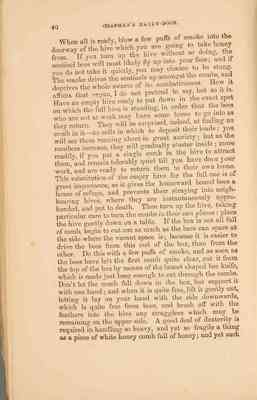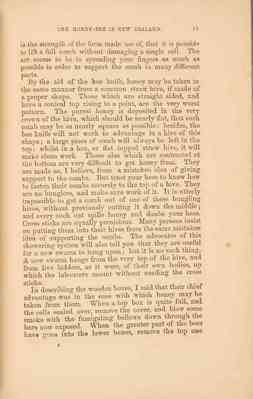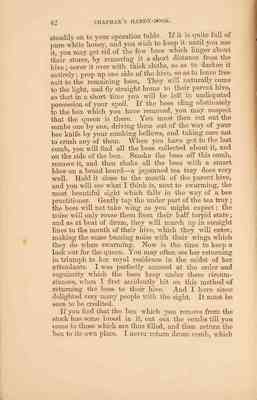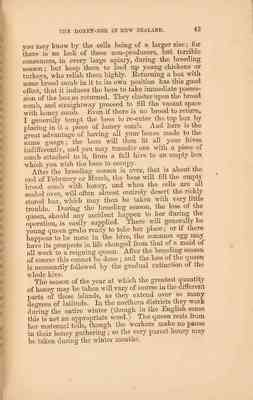Pages
THE HONEY BEE IN NEW ZEALAND 39
ratus, as has been described above, the stillness that reigns in the hive indicates that the bees are in a state of insensibility, the hive may then be turned up for any necessary operations. If honey is wanted, choose the side combs, so as not to interfere with the brood in the centre, and be moderate. Replace the violated hive carefully, and the bees will soon recover from their state of partial intoxication, and set to work to repair the ravages that have been made in their stores. We have always been in the habit, when taking honey, by cutting out the comb, to operate after sundown; but Mr. Cotton says, the time fit for the operation, should be the middle of a sunshiny calm day, between eleven and twelve, when the number of workers who are abroad is greatest; you will so be in less danger of crushing a number of bees as you cut out the combs; besides, if it is later, such bees as may be daubed with honey will not have time to get themselves set to rights by their fellows. In very hot weather take your honey still earlier in the day; for the noontide heat makes the wax so soft, that it is difficult to handle the combs without spoiling them. A damp, cold day, or one when showers may be expected, should not be chosen, as those bees which fall to the ground will be chilled; but some of my pupils may say, how am I to know when my bees have honey to spare? If they are in hives of the candle-box construction, you cannot look in upon them as you may in properly made boxes, which are furnished with windows. But you have their weight to guide you. It is a very good plan to weigh each of your hives and bottom boards before you put bees into them. Mark the weight on the outside, and then simple subtraction at any time will give you the weight of the contents. Even if you have not as yet taken this precaution, you may give a tolerable guess by lifting it a little in your hand, bottom board and all, just before sundown. In the autumn and winter, when the breeding season is over, the weight of the box will give you the actual weight of honey and comb more nearly than in spring and summer. In the latter seasons, a great part of a heavy hive is filled with brood.
40 CHAPMAN'S HANDY NOTEBOOK.
When all is ready, blow a few puffs of smoke into the doorway of the hive which you are going to take honey from. If you turn up the hive without so doing, the sentinel bees will most likely fly up into you face; and if you do not take it quietly, you may chance to be stung. The smoke drives the sentinels up among the combs, and deprives the whole swarm of its combativeness. How it affects that organ, I do not pretend to say, but so it is. Have an empty hive ready to put down in the exact same spot on which the full hive is standing, in that order that the bees who are not at work may have some home to go in as they return. They will be surprised, indeed, at finding no comb in it - no cells in which to deposit their loads: you will see them running about in great anxiety; but as the numbers increase, they will gradually cluster inside; more readily, if you put a single comb in the hive to attract them, and remain tolerably quiet till you have done your work, and are ready to return them to their own home. This substitution of the empty hive for the full one is of great importance, as it gives the homeward bees a house of refuge and prevents their straying into neighbouring hives, where they are instantaneously apprehended and put to death. Then turn up the hive, taking particular care to turn down the combs in their own planes: place the hive gently down on the table. If the box is not all full of comb, begin to cut out as much as the bees can spare at the side where the vacant space is; because it is easier to drive the bees from this end of the box, than from the other. Do this with a few puffs of smoke, and as soon as the bees have left the first comb quite clear, cut it from the top of the box by means of the lancet shaped bee knife, which is made just long enought to cut through the the combs. Don't let the comb fall down in the box, but support it with one hand; and when it is quite free, lift it gently out, letting it lay on your hand with the side downwards, which is quite free from bees, and brush off with the feathers into the hive any stragglers which may be remaining on the upper side. A good deal of dexterity is required in handling so heavy, and yet so fragile a thing as a piece of white honey comb full of honey; and yet such
THE HONEY-BEE IN NEW ZEALAND 41
is the strength of the form made use of, that is possible to lift a full comb without damaging a single cell. The art seems to be in spreading your fingers as much as possible in order to support the comb in many different parts. By the aid of the bee knife, honey may be taken in the same manner as a common straw hive, if made of a proper shape. Those which are straight sided, and have a conical top rising to a point, are the very worst pattern. The purest honey is deposited in the very crown of the hive, which should be nearly flat, that each comb may be as nearly square as possible: besides, the bee knife will not work to advantage in a hive of this shape; a large piece of comb will always be left in the top: whilst in a box, or flat topped straw hive, it will make clean work. Those also which are contracted at the bottom are very difficult to get honey from. They are made so, I believe, from a mistaken idea of giving support to the combs. But trust your bees to know how to fasten their combs securely to the top of a hive. They are no bunglers, and make sure work of it. It is utterly impossible to get a comb out of one of these bungling hives, without previously cutting it down the middle; and every cut spills honey and daubs your bees. Cross sticks are equally pernicious. Many persons insist on putting them into their hives from the same mistaken idea of supporting the combs. The advocates of this skewered system will also tell you that they are useful for a new swarm to hang upon; but it is no such thing. A new swarm hangs from the top of the hive, and from live ladders, as it were, of their own bodies, up which the labourers mount without needing the cross sticks. In describing the wooden boxes, I said that their chief advantage was in the ease with which honey may be taken from them. When a top box is quite full, and the cells sealed over, remove the cover, and blow some smoke wth the fumigating bellows down through the bars now exposed. When the greater part of the bees have gone into the lower boxes, remove the top one
42 CHAPMAN'S HANDY-BOOK
steadily on to your operation table. If it is quite full of pure white honey, and you wish to keep it until you use it, you may get rid of the few bees that linger about their stores, by removing it a short distance from the hive; cover it over with thick cloths, so as to darken it entirely; prop up one side of the hive, so as to leave free exit to the remaining bees. They will naturally come to the light, and fly straight home to their parent hive, so that in a short time you will be left in undisputed possession of your spoil. If the bees cling obstinately to the box which you have removed, you may suspect that the queen is there. You must then cut out the combs one by one, driving them out of the way of your bee knife by your smoking bellows, and taking care not to crush any of them. When you have got to the last comb, you will find all of the bees collected about it, and on the side of the box. Smoke the bees off this comb, remove it, and then shake all the bees with a smart blow on a broad board - a japanned tea tray does very well. Hold it close to the mouth of the parent hive, and you will see what I think is, next to swarming, the most beautiful sight which falls in the way of a bee practitioner. Gently tap the under part of the tea tray; the bees will not take wing as you might expect; the noise will only rouse them from their half torpid state; and as at beat of drum, they will march up in straight lines to the mouth of their hive, which they will enter, making the same buzzing noise with their wings which they do when swarming. Now is the time to keep a look out for the queen. You may often see her returning in triumph to her royal residence in the midst of her attendants. I was perfectly amazed at the order and regularity which the bees keep under these circumstances, when I first accidently hit on this method of returning the bees to their hive. And I have since delighted very many people with the sight. It must be seen to be credited. If you find that the box which you remove from the stock has some brood in it, cut out the combs till you come to those which are thus filled, and then return the box to its own place. I never return drone comb, which
THE HONEY-BEE IN NEW ZEALAND. 43
you may know by the cells being of a larger size ; for there is no lack of these non-producers, but terrible consumers, in every large apiary, during the breeding season; but keep them up to feed young chickens or turkeys, who relish them highly. Returning a box with some brood comb in it to its own position has this good effect, in that it induces the bees to take immediate possession of the box so returned. They cluster upon the broad comb, and straightway proceed to fill the vacant space with honey comb. Even if there is no brood to return, I generally tempt the bees to re-enter the top box by placing in it a piece of honey comb. And here is the great advantage of having all your boxes made to the same guage ; the bars will then fit all your hives indifferently, and you may transfer one with a piece of comb attached to it, from a full hive to an empty box which you wish the bees to occupy. After the breeding season is over, that is about the end of February or March, the bees will fill the empty brood comb with honey, and when the cells are all sealed over, will often almost entirely desert the richly stored box, which may then be taken with very little trouble. During the breeding season, the loss of the queen, should any accident happen to her during the operation, is easily supplied. There will generally be




